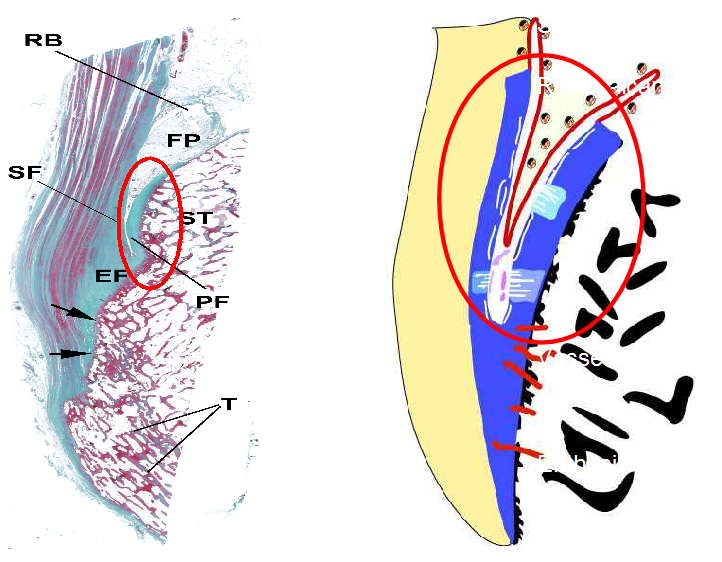Fibrocartilage
Introduction to Fibrocartilage
Articular cartilage is the shock absorbing material on the end of long bones.
Fibrocartilage is the shock absorbing material that is present in most entheses around the body.
Fibrocartilage can by induced by a change in the pattern of joint loading [1].
Thus fibrocartilage can appear and disappear in tendons that are re-routed to confront or avoid bony pulleys [1].
Although researchers talk about articular cartilage and fibrocartilage as having distinct locations both can be:
- Present together
- Articular type cartilage can occur locations where fibrocartilage may be expected
- Fibrocartilage can develop in Articular cartilaginous joints (after micro fracture)
Locations of Fibrocartilage
It is present at the insertion point of tendon and ligament attachments.
It is also present immediately adjacent to insertion sites and may line the bone surface and tendon or ligament.
 |
| The picture on the left is the Achilles enthesis. The sea blue area marked EF is the enthesis fibrocartilage. The image on the right is a corresponding cartoon. The fibrocartilage is a key part of the enthesis organ. The areas inside the red circles show that the adjacent bone and tendon that are also lined by fibrocartilage. The bone region is termed periosteal fibrocartilage. The region on the undersurface of the tendon is termed sesamoid fibrocartilage |
Fibrocartilage is also present in some joints. These include:
- The sacroiliac joint
- The sternoclavicular joint
- The acromioclavicular joint
- The tempomanidibular joint (jaw)
- And the meniscus of the knee
Fibrocartilage is also present at what we have termed functional entheses.
This is where tendons wrap around bones. Such locations include:
- The tibialis posterior tendon
- The peroneal tendons
- Several other tendons in the foot
Fibrocartilage has no blood supply or nerve supply in the healthy state.
 |
| This is a higher resolution image of Fibrocartilage.
1= bone marrow fat
2= bone
3= calcified fibrocartilage
4= fibrocartilage
5= Beginning of tendon
|
Implications for disease
The smooth functioning of the healthy skeleton is linked to the enthesis fibrocartilage ability to withstand stress.
Fibrocartilage has no blood supply or nerve supply in the healthy state.
In older subjects, abnormal blood vessel and nerve fibre ingression into the fibrocartilage is associated with many disease states.
In youth, overgrowth of the fibrocartilage may be associated with "Jumpers knee" and other problems.
References
 [note - this paper by Benjamin and Evans is
free online and clearly written
and very comprehensible to the non-expert].
[note - this paper by Benjamin and Evans is
free online and clearly written
and very comprehensible to the non-expert].